If you are reupholstering your furniture, choosing the new fabric can be a fun experience– however, it is important that you choose a textile that will work and blend in with your existing space, rather than clashing when you bring your reupholstered pieces home!
Below, we go over some tips and tricks to assist you in choosing colours that will complement your existing walls and floor.
Matching Furniture Colour with Floor Colour
Whether you have carpeted flooring, or hardwood flooring which could range from light wood floors, cherry hardwood floors, to dark hardwood floors, it is important to match the fabric colours of your newly upholstered furniture to the existing space.This will help to make the room more cohesive and put together, rather than the furniture overwhelming the flooring, or vice versa. You want all of the elements in your space to work together.
Take a look at the following tips.
Look at Undertones
The undertones of your existing flooring can be a big clue as to what upholstery colours will work within this space. Colours– whether the carpet colours or wood colours– will have either a warm or cool undertone. You can mix and match fabric colours for your furniture that have the same undertones as your flooring.
For example, cool toned woods, such as those in shades of grey, will combine well with cool toned furniture in colours like blues, purples, or greens. More neutral undertones can match furniture with both warm or cool undertones.
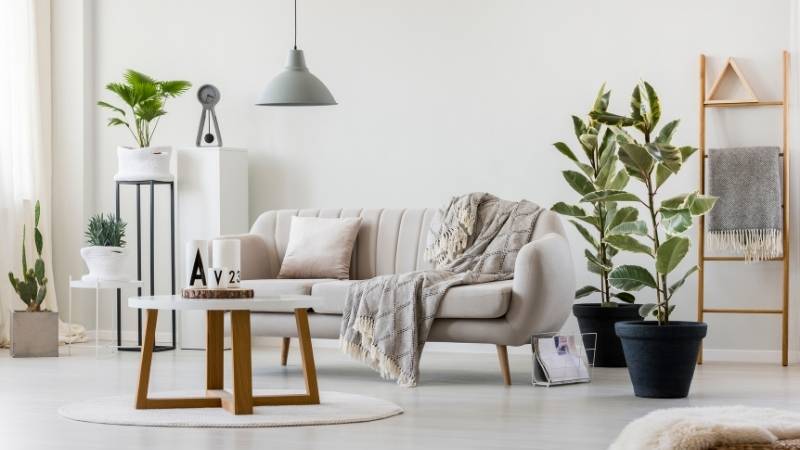
Matching vs Contrast
There are two routes that you can take here– you can either match your furniture to your floor colour, or you can lean into contrasting your furniture and wall colours instead. If you choose to match your colours, you can do so subtly, rather than matching furniture colours exactly to your flooring. For example, you can choose upholstered furniture with wooden legs that match the wood of your hardwood floors, and then make sure that your upholstery colours match the undertones of the flooring, too. This creates balance, while also making sure that your furniture and flooring do not blend together.
On the other hand, you may decide that you would rather create contrast to build more visual interest. This is also an acceptable route to take. In fact, contrast is an important design element. An easy way to create contrast is to choose lighter furniture if you have dark wood floors or dark carpet, for instance, as this will help to make your furniture pop! You should still pay attention to undertones to ensure that these match when you are choosing colours, though. This will prevent the furniture from looking out of place in the room.

Furniture Color Ideas for Matching Floor Color
When it comes to actually choosing the furniture colours for a space, you will certainly want to incorporate the considerations that we discussed above. However, there are still so many colour options out there for your furniture!
We are going to go over some suggestions and examples below, so that you have a jumping off point for decorating the rooms of your own house, no matter what floor colours you decide to go with.
For Cool Toned Wood Floors
Now, we are going to preface this by saying that these rules do not only apply to wood flooring– they apply to carpet, too! As we mentioned before, cool wood tones in flooring translates well to furniture in like colours, so you should look for furniture that features cool tones or cool undertones. This can be found in either wooden furniture or upholstered furniture.
If it is wooden furniture that you are choosing, be sure that you are not choosing wood that matches the wood of your flooring exactly, as this can cause everything to blend together. Instead, choose furniture that is different in colour but has the same undertones.
When it comes to painted or upholstered furniture, look for cool tones as well. Some examples of cool colours are shades of purple, blues, and greens. A good choice for your cool toned room would be to go with shades of green, as these are currently trending colours in the design space.
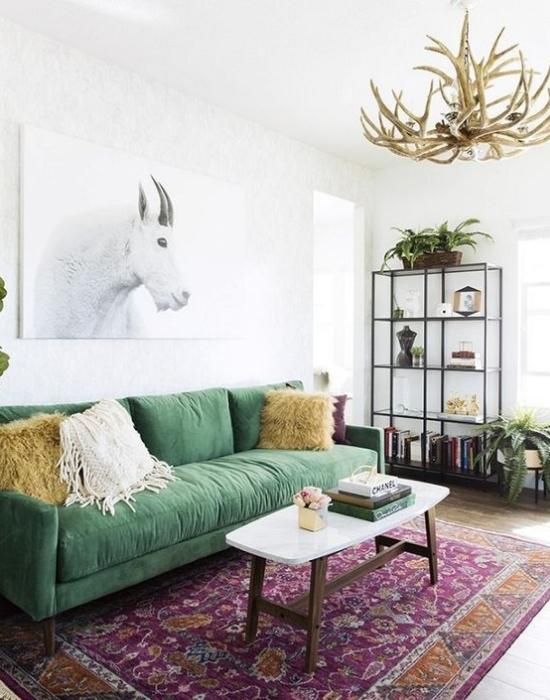
Earthy tones such as greens, browns, and taupes are all very popular right now– you can use the neutral browns or taupes as accents to the shades of green that you choose, to really pull the room together.
For Warm Toned Wood Floors
For warm wood floors– or carpet!– you should do the same as with cool toned flooring above. Look for colours that have the same warm undertone as the flooring you are working with. On the colour wheel, warm toned colours are oranges, reds, and yellows. These may come in bright, popping shades, but can also come in more muted shades, like cranberry or gold. Therefore, you do not have to opt for anything super bright if that is not your style.
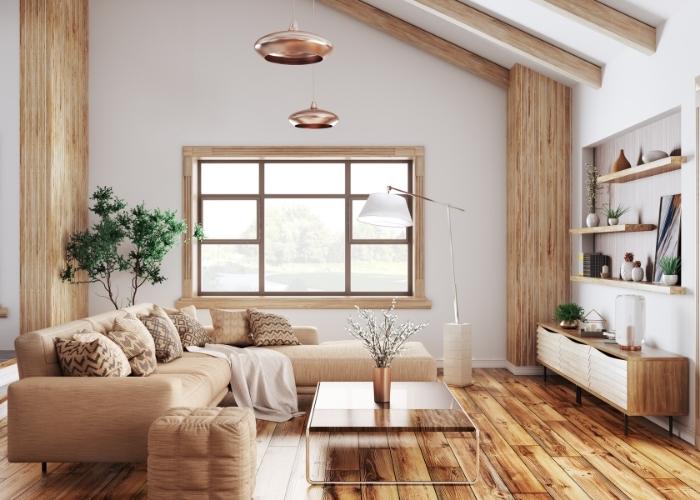
As mentioned previously, earth tones are the big colour trend lately. To stay on trend and ensure that your space looks modern and fresh, try warm tone colours like terracotta or mustard.

Muted shades of pink are also on trend and could be a good pick! Darker shades of these colours can especially pop against light wood flooring.
For Neutral Toned Wood Floors
If your flooring has neutral undertones instead, you have the choice of finding furniture that has these same undertones, or of using either cool or warm toned furniture! Neutral flooring can serve as a backdrop for any colours without competing, especially if you are working with white or grey flooring.
Some examples of neutral tones are greys, shades of white, or tan. Black is another neutral colour. It is important to note that certain shades of these colours can actually be warm or cool, though– for instance, cream is considered a shade of white, but can often have warm undertones!
Matching Furniture Colour with Wall Colour
It is also important to choose furniture colour with your existing wall colours in mind. They can either complement each other, or can play off of each other for a bolder look– however, you want to make sure that your furniture and your wall do not clash. If the combination of furniture and wall colours is too busy, you can also run the risk of making the room seem cluttered and overcrowded to the eye.
Take a look at the following tips.
Look at Undertones
This tip was discussed above, but it can also apply to wall colours. Look at the undertones in your existing wall paint or wallpaper colours to choose what upholstery textile colours you go with.
Warm tones in your wall colours should be matched with upholstered furniture that also has warm undertones, just as cool undertones in wall colour should be matched to furniture with cool tones. This will help to keep your space looking polished and cohesive!
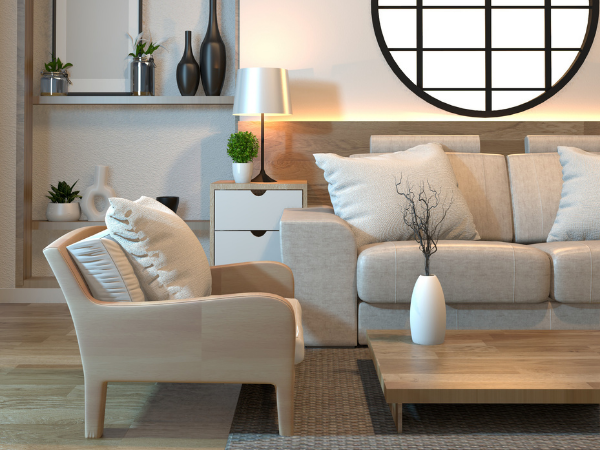
Matching vs Contrast
Just as you can either match or contrast your furniture and floor colours, you can go with either method for your furniture and wall colour, too! If you want to match your furniture and wall colour, be careful that you do not choose the exact same shade of colour. This will cause your furniture to blend in with the walls. Rather, you should choose different shades of this colour, which will add depth and dimension. You can also pull a particular colour from the print of your wallpaper and use this colour for your upholstery choice.
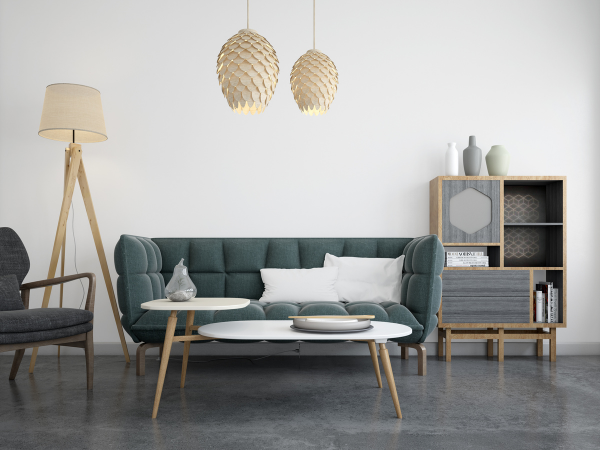
If you want to create contrast, you can choose other fabric colours that match your wall in undertones, but will pop against the existing wall paint or wallpaper. This is a bolder design choice, so it all depends upon your personal aesthetic.

Furniture Colour Ideas for Matching Wall Colour
Choosing furniture colours to match your wall colour is very similar to the process of choosing furniture colours to match your floor. You will still need to consider factors such as undertones, and whether you want to match or contrast with your colour choices.
We are going to discuss some examples of matching furniture colours to your wall colour, so that you can narrow down your options and make choices that will look great in your space!
For Cool Toned Walls
If you are picking furniture to match your walls, rather than your flooring, you will still need to look at the undertones of the wall colouring and compare it to the undertones of the furniture. Undertones are a very important tenet of interior design and decorating, and they ensure that a room feels cohesive and pulled together.
Be sure that you avoid choosing furniture in the same colour as your walls, however, because this can prevent any distinction between walls and furniture in the space. You can experiment with different shades of the same colour, but this can often be intense if overdone, so it is not necessarily for the faint of heart!
Examples of cool colours are greens, blues, and purples. Blues are always a popular choice for decorating a room, as they are a calming colour. Periwinkle blue is also the Pantone Colour of the Year for 2022.

Earth tones are also popular for 2022, so greens would also be a great choice of furniture colour for your space!
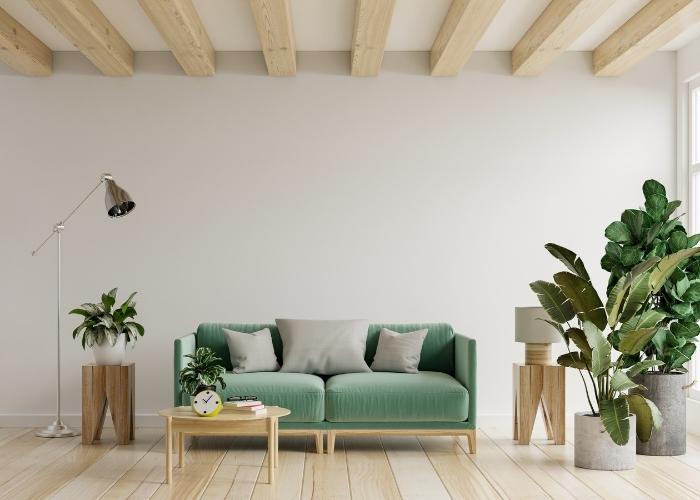
For Warm Toned Walls
Warm undertones, on the other hand, should be matched with warm colours! If your walls are a warm colour, like yellow undertones, for instance, you will want to accent this accordingly with furniture in warm colours, too. Warm colours are shades of red, orange, and yellow.
Muted earth tones are big right now, especially in furniture design, so shades of gold, terracotta, and orange will be easy to find while you are shopping! All of these are on trend and will look great in your warm toned room. Think of the colours that you often saw in 1970s interiors– all of these are back and in fashion again!
Frequently Asked Questions
Should furniture be darker or lighter than the floor?
Technically, you can choose furniture that is lighter or darker than your floor. It just depends on what you want to achieve– lighter floors can provide a contrast for dark furniture pieces to make them really pop. It is recommended, though, that you choose furniture that is a few shades lighter than the colour of your floor.
Does furniture need to match flooring?
Your furniture should not be the same colour as your flooring, or be too close in shades, because then there will be no contrast. This could cause your furniture and flooring to all blend together to the eye. Instead, choose colours that are a few shades lighter than that of your flooring, so that they complement each other and make each other shine. This will make the room look more put together.
How can I match my wood floor color?
If you are looking to match new decor to your floor colour, you should be sure to choose colours that match the current colour temperature of your existing wood floors. This applies to choosing new paint colours for the walls in the room as well.
What wood tones go together?
Typically, the best way to mix and match different wood tones is to look at their undertones. If these different colours of wood match, then they will go together. For example, cherry wood and mahogany have warm undertones, so they should mix and match nicely within a space.

